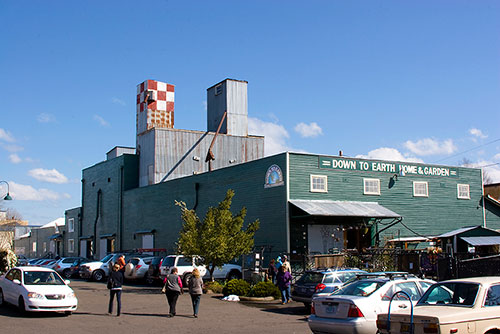A rich history of the Lane County Farmer’s Union Coop (1923)
The historic Farmer’s Union Marketplace at the corner of 5th and Olive Street in downtown Eugene, Oregon has been home to Down To Earth’s flagship store since 1986.
With its rustic wood floors, strong rough cut timbers of the walls and ceilings, old grain bins, hoppers and chutes it gives customers a peek into the past as they walk through the building. The large checkered red and white Purina logo stands on the tallest tower and is a trademark of the building.
The Farmer’s Union building, built in 1923, replaced a smaller Farmers’ Union Cooperative building which was previously a blacksmith shop. Back in the days when agriculture was king, this cooperatively owned complex of buildings served to make local farming economically viable. The old brick paving on the sidewalk is a remnant of the original blacksmith building. The building was owned by a cooperative of several hundred local farmers. They used it as a place to jointly sell, process, exchange and buy materials. It was also open to the general public and today some of our older customers share stories of weighting their sheep here or filling a grain sack when they were teens.
The building has undergone five additions between 1923 and the early 1940’s, practically all of them using the volunteer labor and salvaged materials, quite consistent with the frugal and make-do practices of the agricultural economy of the era. In the late 1940’s the Farmers’ Union Cooperative was ended and the building taken over by Lane County Feed and Seed Company, who continued using it as a feed and seed processing facility for 40 years. In the late 1980’s Lane Feed fell into bankruptcy and the building was taken over by several local investors who retained the historic flavor of the building. They also registered ownership of the property by its original title, Farmers’ Union.
The Pacific Cooperative building which today houses Mountain Rose Herbs Mercantile and Annex, Farmer’s Union Coffee Roasters, and Oak Street Vintage was built in 1928 in three months at a cost of $13,000. It was constructed to receive chicken eggs from local egg producers. Here the eggs were received, inspected, waxed and stored. Receiving occurred on the north side where farmers would unload from 5th Avenue into several large loading doors still visible today.
Although grain no longer rumbles through the chutes, the original character and many of its features remain today. When visiting with us, be sure to take a moment, look around and remember a simpler time when hard work, community and local resources came together to create one of Eugene’s most historical treasures.

